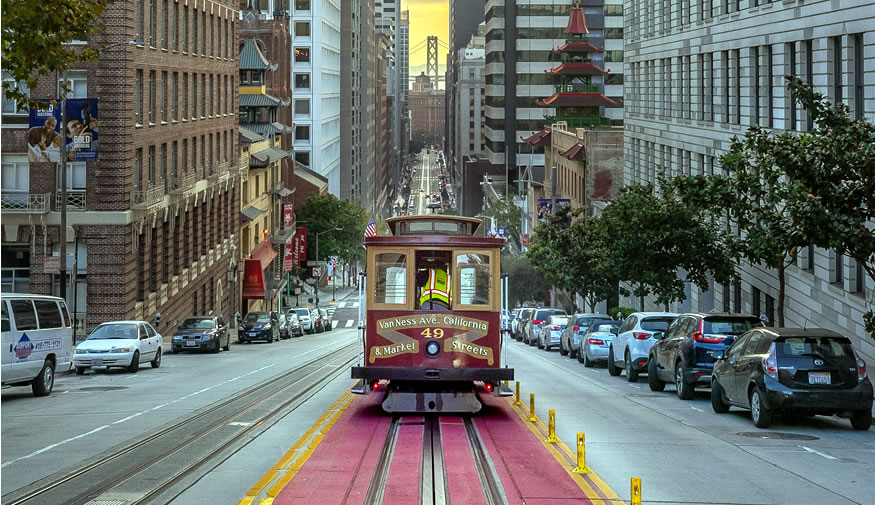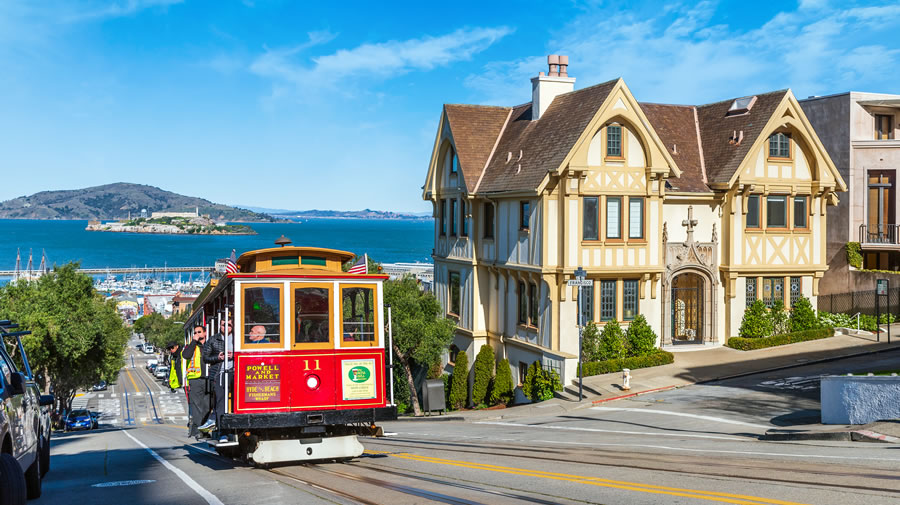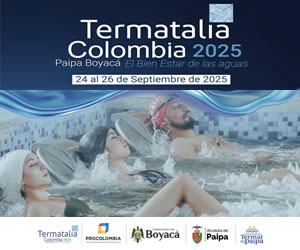Int. en Inglés | San Francisco's cable cars are one of the only moving National Historic Landmarks
San Francisco celebrates 150 years of cable cars
The San Francisco Municipal Transportation Agency (SFMTA) and its nonprofit preservation partner, Market Street Railway, have joined together with a dozen organizations, including business and merchant groups and history and preservation nonprofits, to stage a slate of special events in the Summer and Fall of 2023 to celebrate the 150th anniversary of cable cars, San Francisco's iconic symbol.
24.06.2023 21:49 | San Francisco Travel |
The six-month-long series of events include the first-ever public tours of the Muni shop in San Francisco's Dogpatch neighborhood, where cable cars are built and rebuilt; history-themed walk/ride tours of neighborhoods served by the cable car lines; the planned operation of “ghost” cable cars from disappeared lines, and a reenactment of cable car founder Andrew Hallidie's historic first run. All are detailed on sfcablecars.org.
San Francisco's cable cars are one of the only moving National Historic Landmarks.
“For the last 150 years, residents and visitors have enjoyed the incredible experience of riding our cable cars through our neighborhoods to experience stunning bay views that are famous all over the world,” said San Francisco Mayor London Breed. “You cannot imagine San Francisco without our iconic cable cars. In celebration of the 150th anniversary, we invite everyone to ride our wonderful cable cars to experience the magic of San Francisco.”
The six-month-long celebration kicked off on June 13 at California, Drumm and Market Streets, when Mayor Breed, Board of Supervisors President Aaron Peskin and SFMTA Director of Transportation Jeffrey Tumlin joined civic, business and neighborhood leaders to ride the oldest surviving cable car, 'Big 19', originally built for service on Market Street in 1883 and one of the largest cable cars ever built. The inaugural ride took them through the Financial District, Chinatown and over Nob Hill to Polk Gulch and Van Ness Avenue.
“San Francisco is famous for creating wonderful civic events, and what could be more wonderful than celebrating 150 years of cable cars,” said Jeffrey Tumlin, SFMTA Director of Transportation. “SFMTA owns and operates the cable cars as part of Muni, but really, they belong to everyone, and we invite people from around the world, around the Bay, and around the block, to enjoy our iconic cable cars.”
“No other city in the world has cable cars. San Francisco was the first city with cable cars, and since 1957, we've been the only city to run them,” said Rick Laubscher, President of Market Street Railway. “Our special 150th anniversary website, sfcablecars.org, is filled with cable car history and little-known stories. It also makes it easy to combine cable car rides with walking tours of Chinatown, the Barbary Coast, Fisherman's Wharf, Nob Hill, Russian Hill, Union Square, Polk Gulch and the Financial District. It's a great year to rediscover San Francisco and the cable cars.”

Cable Car Anniversary Events and Programming
The cable car that starred in the kickoff event is unique. In the 1880s, it was open-sided and carried throngs of riders from the Ferry Building out Market and Haight streets to enjoy Golden Gate Park. After the 1906 earthquake and fire, 'Big 19' moved to the Sacramento-Clay route, successor to Andrew Hallidie's original 1873 cable car line, and ran there from 1907 until 1942, when that line shut down. Restored by Muni crafts workers, 'Big 19', one of the largest cable cars ever built, it inaugurated the celebration with a trip up California Street through Chinatown and over Nob Hill, just two blocks south of inventor Hallidie's Clay Street line.
Later in the summer, Muni hopes to have 'Big 19' in regular service every Saturday on the California Street line through the fall as part of the celebration. Likewise, if work can be completed, Muni plans monthly operation of cable car 42 on its original Hyde Street trackage. Cable car 42 ran the O'Farrell, Jones & Hyde line until 1954, when the southern half of the line was abandoned, and the tracks on Hyde were connected to part of a Powell Street line. Car 42 retains its original 1907 paint scheme and details. Decades after being sold as surplus to a cattle rancher in Santa Barbara County when the O'Farrell line closed, Market Street Railway brought it back to San Francisco and worked with Muni to restore it for service.

On the actual 150th anniversary date, August 2, history reenactors portraying Andrew Hallidie, Emperor Norton, Domingo Ghirardelli, Lotta Crabtree and other notable San Franciscans from 150 years ago will gather at Hallidie Plaza at Powell and Market Streets at 10 a.m. to honor Hallidie's historic first run. A by-invitation luncheon will follow, honoring cable car heroes including Hallidie; Friedel Klussmann, who saved the cable cars in 1947; Senator Dianne Feinstein, who as Mayor personally led the rebuilding of the cable car system 40 years ago; Fannie Mae Barnes, the first woman to work as a “gripman” operating a cable car 25 years ago; and others.
The San Francisco Public Library has compiled a list of cable car books available at its various branches for interested readers. The Main Library's San Francisco History Center will mount an exhibit of historic cable car photos later this summer, in collaboration with the SFMTA Photo Archive. Market Street Railway's free San Francisco Railway Museum on Steuart Street across from the Ferry Building will debut a special exhibit on 150 Years of cable cars in mid-July.
Participating partners in the celebration include the Chinatown Merchants Association, Chinese Historical Society of America, Downtown SF Partnership, Fisherman's Wharf Merchants, Friends of the Cable Car Museum, Pier 39, San Francisco Chamber of Commerce, San Francisco Chinese Chamber of Commerce, San Francisco City Guides, San Francisco Historical Society, San Francisco Public Library, San Francisco Travel Association, SF Heritage and Union Square Alliance.
San Francisco's cable cars are one of the only moving National Historic Landmarks.
“For the last 150 years, residents and visitors have enjoyed the incredible experience of riding our cable cars through our neighborhoods to experience stunning bay views that are famous all over the world,” said San Francisco Mayor London Breed. “You cannot imagine San Francisco without our iconic cable cars. In celebration of the 150th anniversary, we invite everyone to ride our wonderful cable cars to experience the magic of San Francisco.”
The six-month-long celebration kicked off on June 13 at California, Drumm and Market Streets, when Mayor Breed, Board of Supervisors President Aaron Peskin and SFMTA Director of Transportation Jeffrey Tumlin joined civic, business and neighborhood leaders to ride the oldest surviving cable car, 'Big 19', originally built for service on Market Street in 1883 and one of the largest cable cars ever built. The inaugural ride took them through the Financial District, Chinatown and over Nob Hill to Polk Gulch and Van Ness Avenue.
“San Francisco is famous for creating wonderful civic events, and what could be more wonderful than celebrating 150 years of cable cars,” said Jeffrey Tumlin, SFMTA Director of Transportation. “SFMTA owns and operates the cable cars as part of Muni, but really, they belong to everyone, and we invite people from around the world, around the Bay, and around the block, to enjoy our iconic cable cars.”
“No other city in the world has cable cars. San Francisco was the first city with cable cars, and since 1957, we've been the only city to run them,” said Rick Laubscher, President of Market Street Railway. “Our special 150th anniversary website, sfcablecars.org, is filled with cable car history and little-known stories. It also makes it easy to combine cable car rides with walking tours of Chinatown, the Barbary Coast, Fisherman's Wharf, Nob Hill, Russian Hill, Union Square, Polk Gulch and the Financial District. It's a great year to rediscover San Francisco and the cable cars.”

Cable Car Anniversary Events and Programming
The cable car that starred in the kickoff event is unique. In the 1880s, it was open-sided and carried throngs of riders from the Ferry Building out Market and Haight streets to enjoy Golden Gate Park. After the 1906 earthquake and fire, 'Big 19' moved to the Sacramento-Clay route, successor to Andrew Hallidie's original 1873 cable car line, and ran there from 1907 until 1942, when that line shut down. Restored by Muni crafts workers, 'Big 19', one of the largest cable cars ever built, it inaugurated the celebration with a trip up California Street through Chinatown and over Nob Hill, just two blocks south of inventor Hallidie's Clay Street line.
Later in the summer, Muni hopes to have 'Big 19' in regular service every Saturday on the California Street line through the fall as part of the celebration. Likewise, if work can be completed, Muni plans monthly operation of cable car 42 on its original Hyde Street trackage. Cable car 42 ran the O'Farrell, Jones & Hyde line until 1954, when the southern half of the line was abandoned, and the tracks on Hyde were connected to part of a Powell Street line. Car 42 retains its original 1907 paint scheme and details. Decades after being sold as surplus to a cattle rancher in Santa Barbara County when the O'Farrell line closed, Market Street Railway brought it back to San Francisco and worked with Muni to restore it for service.

On the actual 150th anniversary date, August 2, history reenactors portraying Andrew Hallidie, Emperor Norton, Domingo Ghirardelli, Lotta Crabtree and other notable San Franciscans from 150 years ago will gather at Hallidie Plaza at Powell and Market Streets at 10 a.m. to honor Hallidie's historic first run. A by-invitation luncheon will follow, honoring cable car heroes including Hallidie; Friedel Klussmann, who saved the cable cars in 1947; Senator Dianne Feinstein, who as Mayor personally led the rebuilding of the cable car system 40 years ago; Fannie Mae Barnes, the first woman to work as a “gripman” operating a cable car 25 years ago; and others.
The San Francisco Public Library has compiled a list of cable car books available at its various branches for interested readers. The Main Library's San Francisco History Center will mount an exhibit of historic cable car photos later this summer, in collaboration with the SFMTA Photo Archive. Market Street Railway's free San Francisco Railway Museum on Steuart Street across from the Ferry Building will debut a special exhibit on 150 Years of cable cars in mid-July.
Participating partners in the celebration include the Chinatown Merchants Association, Chinese Historical Society of America, Downtown SF Partnership, Fisherman's Wharf Merchants, Friends of the Cable Car Museum, Pier 39, San Francisco Chamber of Commerce, San Francisco Chinese Chamber of Commerce, San Francisco City Guides, San Francisco Historical Society, San Francisco Public Library, San Francisco Travel Association, SF Heritage and Union Square Alliance.










